Solar eclipse of February 16, 1980
| Solar eclipse of February 16, 1980 | |
|---|---|
 Map | |
| Type of eclipse | |
| Nature | Total |
| Gamma | 0.2224 |
| Magnitude | 1.0434 |
| Maximum eclipse | |
| Duration | 248 sec (4 m 8 s) |
| Coordinates | 0°06′S 47°06′E / 0.1°S 47.1°E |
| Max. width of band | 149 km (93 mi) |
| Times (UTC) | |
| Greatest eclipse | 8:54:01 |
| References | |
| Saros | 130 (50 of 73) |
| Catalog # (SE5000) | 9464 |
A total solar eclipse occurred on February 16, 1980. A solar eclipse occurs when the Moon passes between Earth and the Sun, thereby totally or partly obscuring the image of the Sun for a viewer on Earth. A total solar eclipse occurs when the Moon's apparent diameter is larger than the Sun's, blocking all direct sunlight, turning day into darkness. Totality occurs in a narrow path across Earth's surface, with the partial solar eclipse visible over a surrounding region thousands of kilometres wide. The path of totality crossed central Africa, southern India, and into China at sunset.
Related eclipses
Solar eclipses of 1979-1982
Each member in a semester series of solar eclipses repeats approximately every 177 days and 4 hours (a semester) at alternating nodes of the Moon's orbit.
| Descending node | Ascending node | |||||
|---|---|---|---|---|---|---|
| Saros | Map | Saros | Map | |||
| 120 |  February 26, 1979 Total |
125 |  August 22, 1979 Annular | |||
| 130 |  February 16, 1980 Total |
135 |  August 10, 1980 Annular | |||
| 140 |  February 4, 1981 Annular |
145 |  July 31, 1981 Total | |||
| 150 |  January 25, 1982 Partial |
155 | 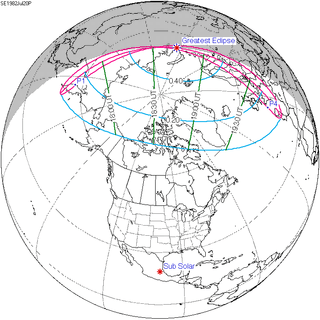 July 20, 1982 Partial | |||
| Partial solar eclipses on June 21, 1982 and December 15, 1982 occur in the next lunar year eclipse set. | ||||||
Saros 130
It is a part of Saros cycle 130, repeating every 18 years, 11 days, containing 73 events. The series started with partial solar eclipse on August 20, 1096. It contains total eclipses from April 5, 1475 through July 18, 2232. The series ends at member 73 as a partial eclipse on October 25, 2394. The longest duration of totality was 6 minutes, 41 seconds on July 11, 1619.[1]
| Series members 43–56 between 1853 and 2100 | ||
|---|---|---|
| 43 | 44 | 45 |
 November 30, 1853 |
 December 12, 1871 |
 December 22, 1889 |
| 46 | 47 | 48 |
 January 3, 1908 |
 January 14, 1926 |
 January 25, 1944 |
| 49 | 50 | 51 |
 February 5, 1962 |
 February 16, 1980 |
 February 26, 1998 |
| 52 | 53 | 54 |
 March 9, 2016 |
 March 20, 2034 |
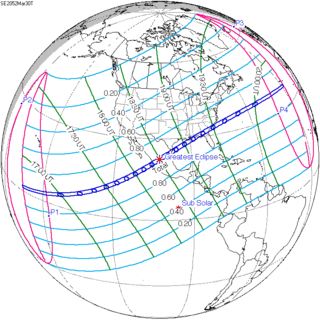 March 30, 2052 |
| 55 | 56 | |
 April 11, 2070 |
 April 21, 2088 | |
Metonic series
The metonic series repeats eclipses every 19 years (6939.69 days), lasting about 5 cycles. Eclipses occur in nearly the same calendar date. In addition the octon subseries repeats 1/5 of that or every 3.8 years (1387.94 days).
| 21 eclipse events, progressing from north to south between July 11, 1953 and July 11, 2029 | ||||
|---|---|---|---|---|
| July 10-11 | April 29-30 | February 15-16 | December 4 | September 21-23 |
| 116 | 118 | 120 | 122 | 124 |
 July 11, 1953 |
 April 30, 1957 |
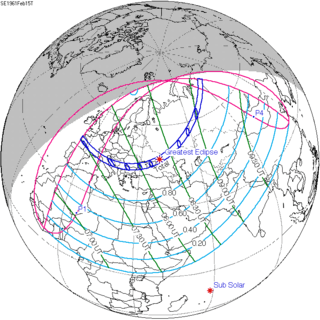 February 15, 1961 |
 December 4, 1964 |
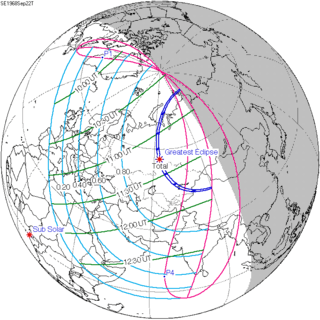 September 22, 1968 |
| 126 | 128 | 130 | 132 | 134 |
 July 10, 1972 |
 April 29, 1976 |
 February 16, 1980 |
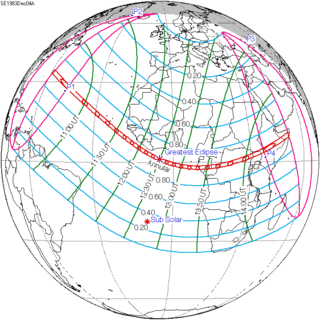 December 4, 1983 |
 September 23, 1987 |
| 136 | 138 | 140 | 142 | 144 |
 July 11, 1991 |
 April 29, 1995 |
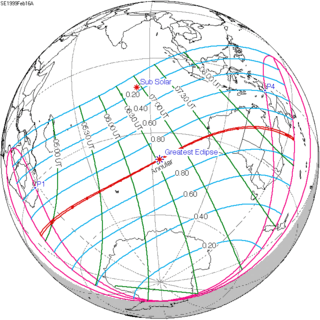 February 16, 1999 |
 December 4, 2002 |
 September 22, 2006 |
| 146 | 148 | 150 | 152 | 154 |
 July 11, 2010 |
 April 29, 2014 |
 February 15, 2018 |
 December 4, 2021 |
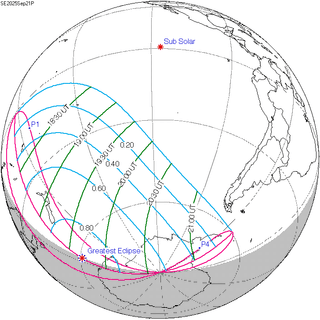 September 21, 2025 |
| 156 | ||||
 July 11, 2029 | ||||
Notes
References
- Earth visibility chart and eclipse statistics Eclipse Predictions by Fred Espenak, NASA/GSFC
- Foto Solar eclipse of February 16, 1980
- Prof. Druckmüller's eclipse photography site, Solar eclipse of February 16, 1980
| Wikimedia Commons has media related to Solar eclipse of 1980 February 16. |
